I’ve been skating with my TSG Pass for a while now, and I’ve put through all kinds of scenarios. Rain, dust, heat, high humidity, snow, you name it! And impressively, this thing has kept me safe and impressively, kept up its performance all the way through. Easily, one of the few bits of kit I have 0 regret buying.
But you should know, it’s not perfect. In my review today, I’ll let you know what’s good and bad about the Pass. After reading it, you’ll be confident about whether this is the right helmet for you.
This article is part 4 of a 5 article series on skateboarding protection. Check out the other articles here:
- 11 essential & non-essential protective gear for downhill skating
- TSG DHP Knee Pads Review
- The 9 best and worst skateboarding helmets‘
- Understanding Downhill Skateboarding Helmets
Why should you consider getting a full-face helmet?
Full-face helmets definitely aren’t cheap pieces of kit. If you’re getting one, your wallet needs to be prepared to take the hit. But what makes them worth it? At what point does someone need to be like, yeah, I REALLY should be getting full-face, despite how expensive they are? You should consider getting a full-face if you can relate to the points below:
- You skateboard very fast – full-faces provide better safety at those higher speeds (think 40mph+), and make the experience less ‘hectic’. To put it simply, imagine the clarity and calmness of skating at 2mph – you don’t have the wind pulling away at your face and eyes, no bugs smacking your face, etc. Now imagine that same clarity and calmness at 50mph (plus a bit of noise). Skating with a full-face allows you to better focus on the road, have a calmer skating experience (and as a by-product, skate a tiny bit better).
- You want to be safe when skating fast – This is because things happen very quickly at those speeds and it’s hard to control how you fall over. Accidents can be a lot more severe and more often than not, a half-shell isn’t enough to keep you well protected. With the safety of your brain, head, and face in the balance, you want to do what you can to keep them safe.
- You skate a lot in winter – skating in winter sucks, full stop. It’s cold, the wind hurts your face and makes your eyes tear up – even when skating really slow. Simply getting a full-face can make the experience a lot more comfortable. It keeps your face warm and makes you enjoy skating in the coldest part of the year.
- You’re thinking of attending IDF events – full-faces are typically mandatory at most (if not all) IDF events. If you’re thinking of attending a sanctioned event, a full-face is exactly what you need.
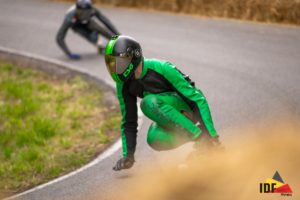
Do you really need a full-face just yet?
OK, so I’ve convinced you to buy a full-face and you’re slowly boarding the TSG Pass hype train. But before we get into the review I need you to take a step back and really ask yourself, do you really need a full-face?
This is especially important because as I mentioned earlier, these things don’t come cheap. At around $200, these things are a big investment for the typical person. The Pass is one of the cheaper models on the market, but nonetheless, still costly.
If you’re a beginner downhill skater, check out my review of the best helmets in the market here. You might find something more suitable for your needs.
Why might a full-face not be the right thing for you?
- You are mainly sessioning slow neighborhood corners – full-faces are really overkill for your basic neighborhood skate sessions, in terms of safety and appropriateness. Beginner skaters should really try and stick to half-shells.
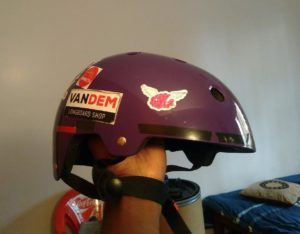
- You spend a majority of your time skating under 40mph – at these speeds, falling over can be handled by your typical half-shell. A half-shell can be just as good as a full-face if used appropriately.
- You get back up your hill by walking – full-faces get really hot and it doesn’t make them any more enjoyable to wear if you are sweaty and hot from walking/pushing back up the hill. It is also really not nice to constantly have to take your full-face on and off (your ears take a beating and can get chaffed).
But the above said, all skaters are different and do have different needs. Take my advice and judge your personal situation accordingly.
Should E-skaters get a full-face?
If you are an E-skater, you should definitely get a full-face. Most e-skaters are ‘beginners’ when it comes to skateboarding – they typically don’t have the same experience ‘normal’ skaters do, and as such haven’t developed the muscles and experience to balance adequately at higher speeds, and as such are at a higher risk at those speeds.
Yes, tightening your trucks and lowering the angle of your back truck helps with stability, but that simply is not a substitute for skill and experience.
Another issue is that they start going fast pretty quick. I would think it crazy for a beginner longboarder to start going over 30mph within a few sessions, and Eskaters typically do it in fewer.
So yes, I think full-face helmets should be mandatory for most e-skaters. Yes, some of the full-faces look kooky (fortunately, the Pass is kinda stylish), but they are definitely worth using to keep your head safe.
In summary, Eskaters should get full-faces to ensure they are well-protected. A lot of them don’t have the same experience downhill skaters do and can get themselves into really messy situations.
TSG Pass Review
TSG Specifications
- Sizes
- S – 54-56 cm / 21.3-22 in
- M – 56-58 cm / 22-22.8 in
- L – 58-60 cm / 22.8-23.6 in
- XL – 60-61 cm / 23.6-24 in
- Certifications – ASTM F1952 & EN 1078
- Comes with two removable visors – clear/silver
- D-ring strap
- Removable cheek and head pads
- Comes with replaceable mouth pad
Is it heavy?
This first thing I noticed about the TSG was its weight. As I expected, it weighed more than the basic half-shell, but didn’t feel especially heavy too heavy. This is because whilst it does have a lot more EPS foam around the head area, its shell is made from fiberglass. This makes it a lot stronger and lighter in comparison to the plastic shell typically used in half-shells.
It also doesn’t have much padding and EPS foam in on the chin bar, which probably contributes to its lightness. It’s also nice because it keeps the balance/weight closer to the back of your head.
One thing I did notice, is that my neck felt a bit sore after the first few sessions of wearing this helmet. It felt especially sore after being in tuck for long periods of time and having to hold my head up. However, my neck did get stronger and I was able to hold up the helmet as time went on. But those days of being sore definitely weren’t nice.
Is the visibility of the TSG good for downhill skating?
The visibility of the TSG is quite good. The front bit of the helmet is cutout and extends from just behind where your eye socket ends, to under your cheeks, under your nose, and to where your hairline meets your forehead. Practically, this allows you to see really, really well – almost complete 180* vision. You get to have great peripheral vision too.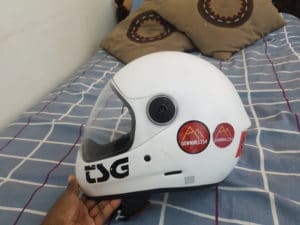 Finally, because of where the top bit of the helmet extends to (just to your hairline), you get to see out of the tuck really well. I could see out of my tuck without the helmet obstructing my vision, unlike how a half-shell would. With my half-shell, I would have to slightly modify my tuck by raising my head higher in order to see properly, something other people experienced too. The Pass comfortably allows you to bring your chin down to your knee and still see out comfortably.
Finally, because of where the top bit of the helmet extends to (just to your hairline), you get to see out of the tuck really well. I could see out of my tuck without the helmet obstructing my vision, unlike how a half-shell would. With my half-shell, I would have to slightly modify my tuck by raising my head higher in order to see properly, something other people experienced too. The Pass comfortably allows you to bring your chin down to your knee and still see out comfortably.
To learn more about downhill skate helmets, check out my article here, explaining everything you need to know.
Is it comfortable and how does it fit?
Size-wise, I got the S helmet because it was cheaper. but also because my head fit within the sizing requirements.
But I will admit though, my head is all-around a bit bigger than average, so my experience may not truly reflect what you will have in this regard – I think it’s pretty ‘big’ in terms of height … lol.
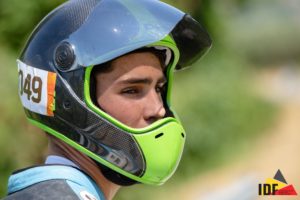
The helmet comes in one shell size, and the sizing changes with how thick the padding is. So if you want a tighter or looser fit, you can simply change the cheek pads.
The shell also stretches a tiny bit when you put it on, and I have noticed that the padding does get a bit more packed in the more I wear it – so if the helmet is a bit tight, give it some time, wear it often, and it will feel better.
Finally, if I haven’t cut my hair for a long time, the helmet fits REALLY snuggly and can feel a bit tight (but not uncomfortably tight). It usually feels most comfortable after a haircut. So this may be something to keep in mind if you like to have a lot of hair – perhaps even consider getting a larger sized helmet or simply cut it all and rock the skinhead look?
How does it feel in the tuck?
The helmet feels great and feels natural in the tuck. The visibility is great and it allows you to get your head down really close to your knee whilst still allowing you to see relatively clearly. The helmet doesn’t get in the way of your tuck – much or at all.
Finally, as I had mentioned above, it does feel a bit heavy when you’re tucking with it, but it’s something you get used to after a few sessions and regular use. 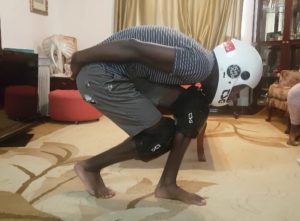
It has a removable visor
The TSG visor is removable. So you can take out if you so wish. This is nice for those hotter days, or if you simply want a cooler skate experience – especially nice in warm climates.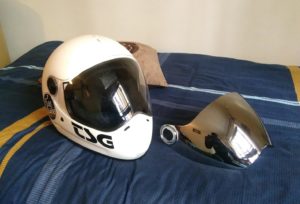 However, I do think that having a visor is what makes a full-face a really beneficial, so I wouldn’t advise taking it out. And to fix the heat issues, you can simply lift the visor to occasionally let the trapped hot air out.
However, I do think that having a visor is what makes a full-face a really beneficial, so I wouldn’t advise taking it out. And to fix the heat issues, you can simply lift the visor to occasionally let the trapped hot air out.
Finally, it comes with a silver visor that you can switch the clear one with. This is nice for swag points, or if you want something that dims the sun and bright lights a bit more.
Is it hard to hear out of the helmet?
The TSG does dull outsides sounds quite a bit. You can still hear things like cars, horns, someone clapping their hands/pucks, and other stuff. However, some sounds may/will escape your hearing. I do advise you keep you look around occasionally, to be sure of whats going on around you.
Does the visor fog up? What about ventilation?
The helmet has two ways of dealing with fog and ventilation. It has channels grooved into the EPS that allow air to flow through them in an attempt to provide cooling around the head. There are also tiny holes on the chin guard, to help provide air directly to your nostrils as you breath.
The helmet features a simple nose guard that typically rests just underyour nose. The purpose of this guard is to direct any air you breathe out from your mouth, down and away from the visor. In theory, this helps deal with your hot breath, which can cause the visor to fog up.
But it’s not 100% perfect and the visor does fog up occasionally. However, you can always rub toothpaste, saliva, soap, or baby shampoo on the visor (and rub it dry with a dry, clean cloth). This helps prevent water from condensing on the visor and stops it from fogging up.
Thanks to Guido Isaac Peralta from FB for the fog prevention tips! 🙂
Is the TSG Pass safe, what certifications does it have?
The TSG Pass is safe and has passed all the necessary certifications. It has the:
- American Society for Testing and Material – ASTM F1952. A downhill mountain biking standard for helmet safety, more than relevant and applicable to downhill skating.
This rating is great because ASTM typically have high standards for their certifications. Their ratings are usually the most desirable one to have. - The European standard – EN 1078. A standard for biking helmets that ensures an impact is reduced to 250g, well below the 300G value where impact forces start to cause brain damage.
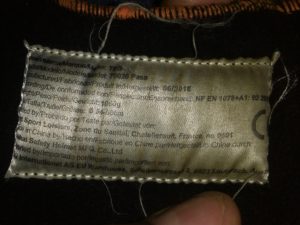
**Remember the idea of a helmet is to prevent brain injuries – not concussions. At 250Gs, you might get a concussion, but the important thing is that you’ll be able to walk away from it and get on with your life.
What’s not so good about the TSG Pass?
- Taking the helmet on and off many times does chafe your ears, especially if your helmet is tight-fitting. Naturally, you will take it off at the bottom of the hill, then put it back on at the top, so if you’re skating a ton on a given day your ears may feel a bit sensitive at the end of it all.
- The weight – whilst this is something you will quickly get used to, it can make your experience uncomfortable initially.
- It’s not so good in hot weather and hot air builds up in it quite easily (which can be a nice thing when skating in really cold weather). However, this issue is easily fixed if you simply lift the visor occasionally to let hot air out – you can also completely remove the visor if you wish,
- The visor is also not that great in wet weather – it can fog up sometimes and water droplets collect on it. But as I said earlier, it is removable so you can take it out. As well, skating in the rain simply sucks for visibility so it is an all-around problem.
What other sports can use the Pass?
- As I said earlier, E-skaters can make use of it. A stylish helmet that is safe for speeds greater than 60mph, what more could they ask for?
- Cyclists too, but I don’t think a lot of them would fancy it. Though a visor might be nice for cycling in winter and at night.
- Downhill cycling – This is easily the obvious choice … I think a lot of the points made on my article probably apply to downhill biking too …
- Downhill Karting – Great visibility, protection …
- Downhill rollerblading – Quite similar to skating in a lot of ways – I think the TSG Pass would be more than appropriate.
- Luge – Similar to skating. The great visibility of the TSG makes it desirable as Luge helmet I think – but haven’t actually seen a lot of lugers using it. Predators and Vectors do seem like popular options …
- Drift triking – A helmet with great visibility that isn’t too heavy?
- Racing pit crews … If I’m not wrong, theres a racing team out there that uses the Pass – I was hoping I’d remember which and be able to pull up an image, but the name escapes me … if you know which team it is, send me a message and let me know!
Check out the image below! Sent in by my friend Guido Isaac Peralta. Thanks for sharing this bro!
But with the great visibility of the TSG, I can see why they would pick it. Protection wise, I don’t think it can deal that well with high-velocity shrapnel (you know, if there is an explosion or accident on track) but they are the experts so …
Where can you buy the TSG Pass?
You can buy it here on Amazon.com.
You can also check out your local skate shop or any online store convenient for you – some cycling stores may even carry it.
Your turn, what do you think?
I definitely think the TSG Pass is worth the money. It might be a costly venture for a lot of people, but I honestly don’t think they would be disappointed with their investment.
However, if money is tight – which it always is for a lot of you people, you can always purchase a mountain biking helmet in place of the pass. These helmets have similar safety certifications and perform similarly to the pass – so you’ll be well protected and have a helmet in similar shape. They are also much cheaper at around 60+ dollars. But the reason these aren’t much more popular is that they aren’t purpose-built for downhill, and this really shows in their overall performance. But with all that said and done, they are still great options if you are on a tight budget.
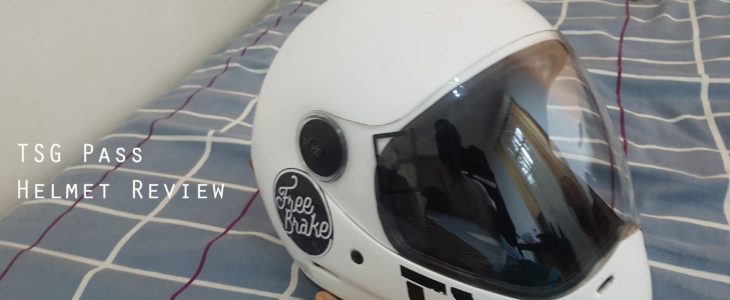
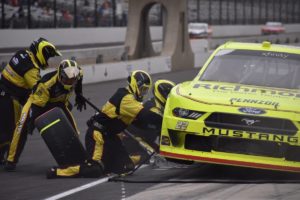
3 comments on “TSG Pass Helmet Review”
Davis
April 23, 2020 at 5:26 pmAbsolutely love my TSG Pass Pro.
There is only one con for me with this helmet that I thoroughly dislike. It is the very small snap button on the strap when doing up. I continually have issue with joining it together. Once snaps is fine and holds no issue. Others in my group of friends have the same quip about it.
AbugaA
April 27, 2020 at 11:12 pmhaha it is annoying. Especially when you have to do it up when you have gloves on.
Eugene Olton
August 16, 2021 at 9:24 pmI considered the pass also. Not for longboarding, not for racing, i am looking for a full face helmet for stand up e-scootering. Somewhat faster than a bicycle (13-30’s mph), a scooter helmet should have more robust protection than a bicycle helmet, good ventilation for warmer weather, all for simple commuting and not adventure riding (motorcycle and downhill helmets would suffice for that. I want a retractable 3/4 to full face shield to block wind caused dry eyes and small objects from getting in my eyes. A chin bar isn’t needed but a minor one would be acceptable. With all the cottage industries creating full face helmets for watersports, skydiving, longboard downhill racing, etc I’m surprised I have not found my helmet answer in such a growing industry and excellent answer to urban transportation and climate change.